
Is this woman spinning clockwise or counterclockwise?

Is this woman spinning clockwise or counterclockwise?
Miss Mildred West, whose duties on the Alton [Ill.] Evening Telegraph include the writing of obituaries, has been taking a week’s vacation. And, for the first time in the memory of her fellow workers on the newspaper, a week has passed with no deaths being reported in this city of 32,000. Normally, ten occur every week.
— New York Times, Sept. 1, 1946
Here are three items that I haven’t been able to confirm — I expect the first two are false, but I’m posting them here for what they’re worth. The first is from Henry Thomas and Dana Lee Thomas, Living Biographies of Great Poets, 1941:
An interesting and touching story is told about the manuscript of the first Jungle Book. Kipling gave this manuscript as a present to the nurse who had cared for his first-born child. ‘Take this script,’ he said, ‘and someday if you are in need of money you may be able to sell it at a handsome price.’ Years later, when the nurse was actually in want, she sold the manuscript and managed to live in comfort for the rest of her life.
I can’t verify that anywhere. The second item is from Robert Hendrickson, American Literary Anecdotes, 1992:
Some 5,000 copies of [Steinbeck’s] The Wayward Bus (1947) went up in flames when the truck taking them from the bindery collided with a bus — yes, a wayward bus — travelling on the wrong side of the road.
San Jose State University’s Center for Steinbeck Studies repeated that story in a 1995 newsletter, but it cited Hendrickson as the source. I haven’t been able to confirm it independently.
This last one may be true. The Oxford Dictionary of Thematic Quotations claims that Millvina Dean (1911-), the youngest survivor of the Titanic disaster, while visiting the Kansas City house in which her family would have lived, said, “I can’t bear iced drinks … the iceberg, you know. Perhaps some champagne though.”
The dictionary cites the Times, Aug. 20, 1997, for this quote, but I haven’t tracked that down to confirm it.
A correspondent of the Manchester Sporting Chronicle, thinking that his horse was short-sighted, had his eyes examined by an oculist, who certified that the horse had a No. 7 eye and required concave glasses. These were obtained and fitted on to the horse’s head. At first the horse was a little surprised, but rapidly showed signs of the keenest pleasure, and he now stands all the morning looking over the half-door of his stable with his spectacles on, gazing around him with an air of sedate enjoyment. When driven his manner is altogether changed from his former timidity; but if pastured without his spectacles on, he hangs about the gate whinnying in a plaintive minor key. If the spectacles are replaced he kicks up his heels and scampers up and down the pasture with delight.
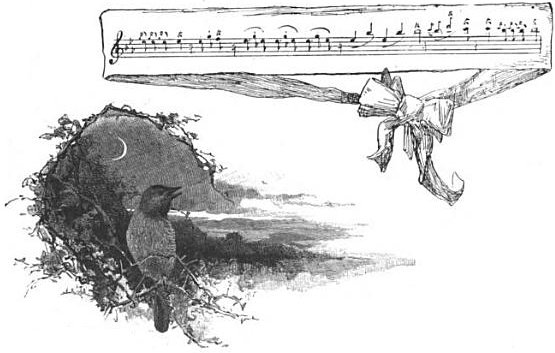
In an 1891 feature, the Strand attempted to notate the songs of various English birds. The nightingale, shown here, “shares with the lark the honours of poesy. Though sometimes dwelling for minutes on a strain composed of only two or three melancholy tones, beginning with a mezza voce, it swells gradually, by a most perfect crescendo, to the highest point of strength, and ends with a dying cadence.”
The songs of birds have long inspired human composers. In 1934 the Rev. K.H. MacDermott, an associate of the Royal College of Music, wrote to the Times:
For many years each spring I have tested the cuckoo’s notes with a piano, and have found that they are always within a tone of D and B, or D and B flat (treble stave). It is of interest to observe that Beethoven, a great lover of birds, when he introduced the imitation of the cuckoo at the end of the second movement of his Pastoral Symphony, gave the two notes D and B flat, to be played by the clarionet. As Beethoven was at the time he composed that work (1808) completely deaf one wonders whether it was by chance he selected the correct notes, or merely because they fit in with the key of the movement, or whether his memory of the bird’s song had survived after he had been unable to hear it for some years. If the latter, it is fascinating to realize that the cuckoo has not altered the pitch of his notes for over a century.
Beethoven used this technique more than once. Ornithologist and bioacoustics expert Luis Baptista of the California Academy of Sciences compared the call of the white-breasted wood wren to the famous opening bars of the composer’s Fifth Symphony:

And if humans imitate birds, Baptista also found that “when birds compose songs they often use the same rhythmic variations, pitch relationships, permutations, and combinations of notes as human composers,” noted Patricia Gray, head of the National Academy of Sciences’ Biomusic program, in Science in 2001. “Thus, some bird songs resemble musical compositions; for example, the canyon wren’s trill cascades down the musical scale like the opening of Chopin’s ‘Revolutionary’ Etude.”
Indeed, birdsong reflects every elementary rhythmic effect found in human music, Gray wrote. “There are interval inversions, simple harmonic relations, and retention of melody with change of key.” Many birds transpose motifs into different keys, and some pitch their songs to the same scale as Western music.
Modern composers have narrowed the gap still further. Olivier Messiaen’s 1952 flute piece Le merle noir was based entirely on the song of the blackbird, and his orchestral work Réveil des oiseaux is built almost entirely on the songs one hears at daybreak in the Jura mountains of the composer’s native France. Critic Paul Griffiths said he considered Messiaen a more conscientious ornithologist than any previous composer, and a more musical observer of birdsong than any previous ornithologist.
This must end somewhere, though. If we’ve been emulating birds’ music, now they’re emulating our technology.

In 1891 the Strand ran two features on oddities encountered by the British post office, which kept facsimiles of the most puzzling letters in three great scrapbooks. “Many a pictorial curiosity passes through the post; and the industrious letter-sorter is often bewildered as to where to despatch missives, the envelopes of which bear hieroglyphics which would positively out-Egypt Egypt.”
Some examples are merely helpless, such as the direction above or a letter intended for Pamber, near Basingstoke, Hants., which was addressed “Pambore near Beas and Stoke, Ence.” Elsewhere, “A seafaring man evidently expected at the Sailors’ Home is addressed, ‘Walstrets, Selorshom Tebiekald for’; which, being interpreted, means, ‘Sailors’ Home, Wells-street: To be called for.”
But others seem deliberately elusive — one letter bore only these lines:

This one:
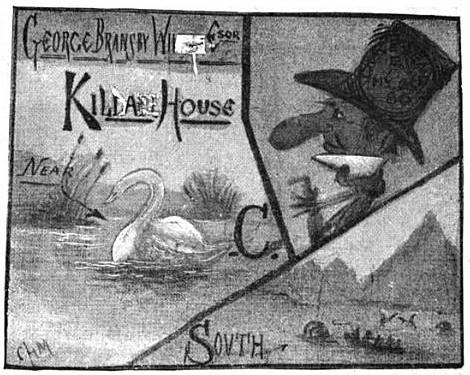
… was intended for Swansea in South Wales.
“One envelope has an ingenious direction on it. It is intended for S.S. Kaisow, lying in the Red Sea. It shows a very deliberate-looking sow labeled K, with a belt round it in the form of the letter C painted red.”
But at least those letters had envelopes. One thrifty correspondent simply wrote his message on the back of a postage stamp and dropped it in the mail:
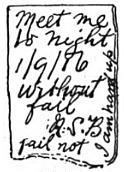
“Meet me to-night without fail. Fail not — I am hard up.” “Though he probably parted with his last penny,” note the editors, “considering the state of his exchequer, he ran a great risk of remaining still hard up, owing to non-delivery of his communication.”
Amazingly, many of these letters actually found their recipients, a testament to the diligence and imagination of the postal authorities. “But we are rather in doubt as to whether a communication from the United States addressed to ‘John Smith, Esq., or any intelligent Smith, London, England,’ or possibly a proposal from some unknown admirer for ‘Miss Annie W—, London, address not known,’ ever reached their rightful owners.”
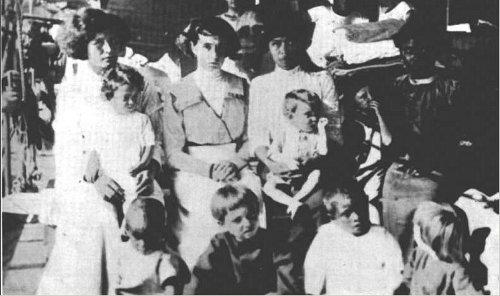
On July 18, 1917, the U.S. Navy gunboat Yorktown called at Clipperton Island, a tiny coral atoll in the eastern Pacific. The ship’s commander, Harlan Page Perrill, sent two men ashore and was surprised to see them return with a complement of women and children. When his men made their report, Perrill later wrote, they revealed “a tale of woe absolutely harrowing in its details.”
The three women and eight children were the only survivors of the island’s original colony, which had once numbered 100. The last ship had visited the island three years ago, and their supplies had given out six months after that. Since that time they had survived on fish, fowl, and eggs. Scurvy and starvation killed much of the population; others died at sea while attempting to escape in a whaleboat. By 1917 lighthouse keeper Victoriano Álvarez was the only man on the island; he declared himself king and began terrorizing the women, threatening, beating, and sadistically raping them, even killing two.
Álvarez had promised to kill Alicia Arnaud, the governor’s wife, when help finally arrived, to prevent her talking to the authorities, but an odd quirk saved her. That very morning, finally determined to act, she and fellow survivor Tirza Randon had confronted Álvarez in his hut, where Randon had killed him with a hammer. Only minutes later, Arnaud’s son had spotted the Yorktown. “What if we had been an hour earlier!” Perrill reflected. “It is almost certain that the man would have killed Señora Arnaud.”
Risking court-martial, Perrill left Álvarez’s body to be devoured by crabs and omitted any mention of him in his official report, and he and the entire crew of the Yorktown kept the secret for 17 years. He later explained that “I was afraid of the effects it might have upon the fortunes of Tirza Randon.” “Had Perrill not sanitized his reports and included titllating details of Álvarez’s reign of terror,” wrote Jimmy Skaggs in his history of the island, “the story undoubtedly would have received far greater attention.”
In September 1924, the wheels of a truck sank into the ground behind the Pelham Courts apartments in Washington, D.C. On investigating, the building’s manager and janitor discovered a mysterious brick-lined passageway that led to a bizarre network of concrete tunnels extending as much as 32 feet underground.
The discovery put Washington into two days of wild speculation. Was this a German plot? A relic of the Civil War? But then Smithsonian Institution entomologist Harrison G. Dyar came forward to admit that he had dug the tunnels when had lived in the capital 10 years earlier. From Modern Mechanix, August 1932:
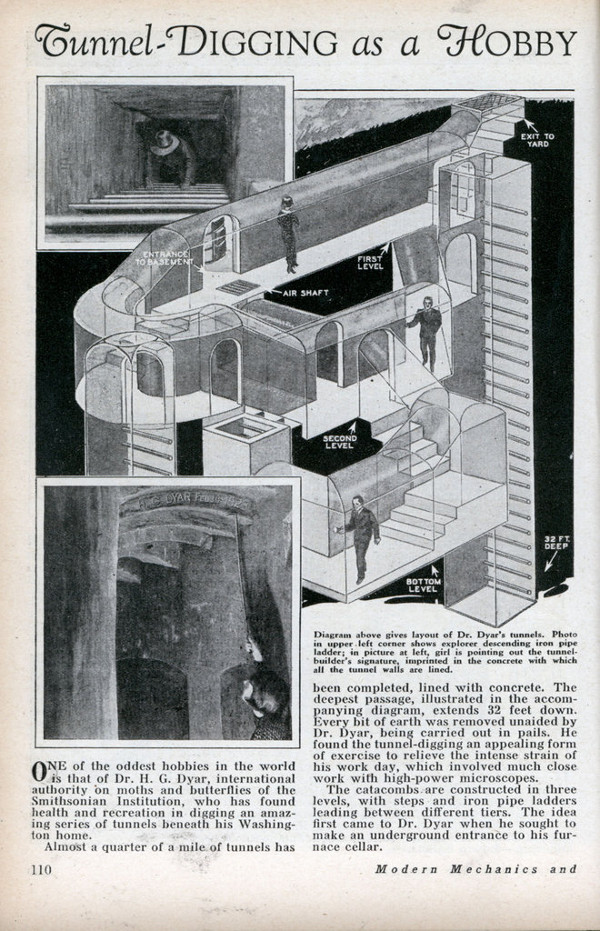
Dyar’s obsession had begun innocently enough. He told the Washington Star that in 1906 he had dug a flowerbed for his wife, and “When I was down perhaps six or seven feet, surrounded only by the damp brown walls of old Mother Earth, I was seized by an undeniable fancy to keep on going.” He had continued the project in secret for 10 years, stopping only in 1915, when he moved out of the area.
“I did it for exercise,” he told the New York Times. “Digging tunnels after work is my hobby. There’s really nothing mysterious about it.”
(Thanks, Allyson.)
Where is pain? If my foot hurts, it’s natural to say that the pain is located in my foot, that I’m perceiving something outside my mind in the same way that I might see a rainbow or smell a rose. The same is true of itches, tickles, tingles, and other bodily sensations.
But this is troubling — suppose I discover that my foot has been amputated, and that the pain exists only in a “phantom limb.” Was I then mistaken? The pain certainly exists somewhere; it seems impossible to be wrong about that. You may convince me that the rainbow is an illusion or the rose an hallucination, but it seems absurd to suggest that one’s experience of pain is mistaken. (Inversely, pain can’t exist without someone’s feeling it. If you anesthetize me and drop a hammer on my foot, the pain isn’t somehow hidden from me — it doesn’t exist at all.)
So pain is strangely private and incorrigible — only I can know whether I’m feeling it, and I cannot be wrong about this impression. It would seem that I can have such authority only if the pain is really in my head. But “it is perfectly OK with common sense that we may have sensations in body parts other than the head — say, under our right foot! Why?” asks University of British Columbia philosopher Murat Aydede. “This, then, is another puzzle about pains and other intransitive bodily sensations: how to properly understand the common practice of locating what appear to be essentially subjective and private sensations in various parts of the body.”
(Murat Aydede, Pain: New Essays on Its Nature and the Methodology of Its Study, 2005.)
How very intimate the bodily sense is can be seen by performing a little experiment in your imagination. Think first of swallowing the saliva in your mouth, or do so. Then imagine expectorating it into a tumbler and drinking it! What seemed natural and ‘mine’ suddenly becomes disgusting and alien. Or picture yourself sucking blood from a prick in your finger; then imagine sucking blood from a bandage around your finger! What I perceive as belonging intimately to my body is warm and welcome; what I perceive as separate from my body becomes, in the twinkling of an eye, cold and foreign.
— Gordon W. Allport, Becoming: Basic Considerations for a Psychology of Personality, 1960